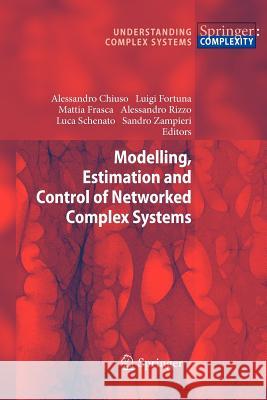Modelling, Estimation and Control of Networked Complex Systems » książka
Modelling, Estimation and Control of Networked Complex Systems
ISBN-13: 9783642260179 / Angielski / Miękka / 2012 / 238 str.
Modelling, Estimation and Control of Networked Complex Systems
ISBN-13: 9783642260179 / Angielski / Miękka / 2012 / 238 str.
(netto: 559,69 VAT: 5%)
Najniższa cena z 30 dni: 578,30 zł
ok. 20 dni roboczych.
Darmowa dostawa!
The paradigm of complexity is pervading both science and engineering, le- ing to the emergence of novel approaches oriented at the development of a systemic view of the phenomena under study; the de?nition of powerful tools for modelling, estimation, and control; and the cross-fertilization of di?erent disciplines and approaches. One of the most promising paradigms to cope with complexity is that of networked systems. Complex, dynamical networks are powerful tools to model, estimate, and control many interesting phenomena, like agent coordination, synch- nization, social and economics events, networks of critical infrastructures, resourcesallocation, informationprocessing, controlovercommunicationn- works, etc. Advances in this ?eld are highlighting approaches that are more and more oftenbasedondynamicalandtime-varyingnetworks, i.e.networksconsisting of dynamical nodes with links that can change over time. Moreover, recent technological advances in wireless communication and decreasing cost and size of electronic devices are promoting the appearance of large inexpensive interconnected systems, each with computational, sensing and mobile ca- bilities. This is fostering the development of many engineering applications, which exploit the availability of these systems of systems to monitor and control very large-scale phenomena with ?ne resoluti
The paradigm of complexity is pervading both science and engineering, leading to the emergence of novel approaches oriented at the development of a systemic view of the phenomena under study; the definition of powerful tools for modelling, estimation, and control; and the cross-fertilization of different disciplines and approaches. This book is devoted to networked systems which are one of the most promising paradigms of complexity. It is demonstrated that complex, dynamical networks are powerful tools to model, estimate, and control many interesting phenomena, like agent coordination, synchronization, social and economics events, networks of critical infrastructures, resources allocation, information processing, or control over communication networks. Moreover, it is shown how the recent technological advances in wireless communication and decreasing in cost and size of electronic devices are promoting the appearance of large inexpensive interconnected systems, each with computational, sensing and mobile capabilities.











